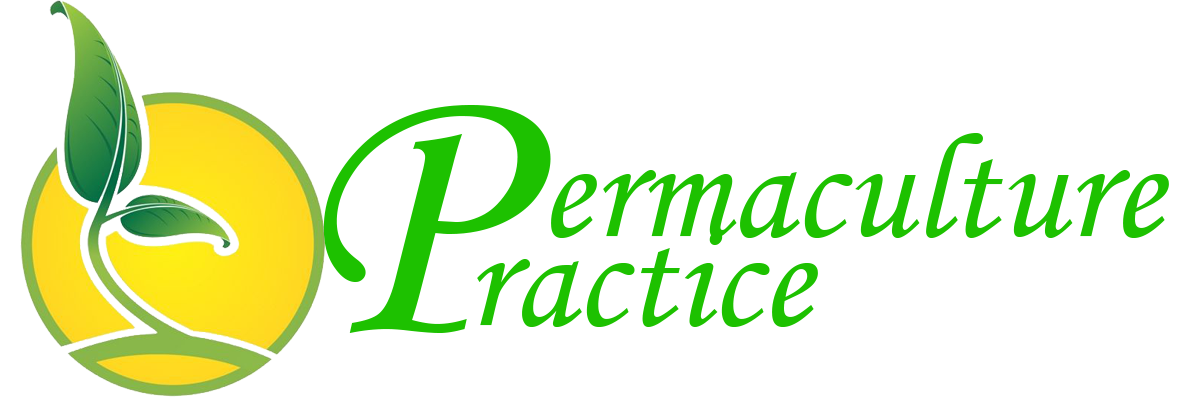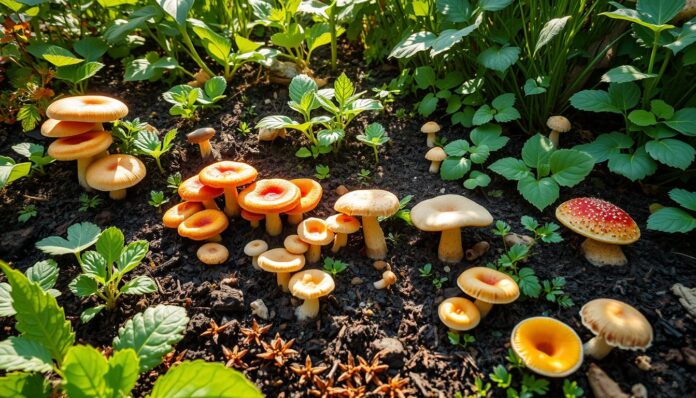Imagine a way to manage pests and keep soil healthy without harming the environment. Permaculture, a design system that works with nature, offers this solution. It uses natural pest control methods like mycopesticides, reducing the need for harmful chemicals.
This approach not only helps the planet but also supports sustainable farming. It improves soil health and boosts local food access. With more people turning to no-till farming and community food forests, the interest in eco-friendly farming grows.
Permaculture focuses on diverse ecosystems, making them more resilient than single-crop farms. Studies show that permaculture food can be up to 50% more nutritious than conventional food. By adopting permaculture and natural pest control, we can build a sustainable food system that values soil and environment.
Key Takeaways
- Permaculture offers a sustainable and environmentally friendly way to manage pests and maintain soil health
- Using natural pest control methods like mycopesticides can reduce the need for chemical pesticides by approximately 70%
- Permaculture systems can produce food yields that are up to 50% more nutritious than those from conventional methods
- Embracing permaculture and natural pest control methods can help create a more sustainable food system
- Permaculture principles prioritize soil health and environmental sustainability, making it an attractive option for those looking to adopt more eco-friendly farming methods
- By applying permaculture principles, we can reduce our reliance on chemical pesticides and fertilizers, promoting sustainable agriculture and improving soil health
Understanding Permaculture and Its Principles
Permaculture is a design system that works with nature to create sustainable living environments. It uses permaculture principles to design ecosystems that are diverse, resilient, and productive. Bill Mollison says permaculture is about design, values, ethics, and caring for the earth.
At its core, permaculture focuses on eco-friendly practices to reduce waste and increase efficiency. It can be applied in agriculture, urban planning, and conservation. For instance, permaculture can help design sustainable food systems, restore ecosystems, and promote biodiversity.
Some key permaculture principles include:
- Observe and interact with nature
- Catch and store energy
- Obtain a yield
- Apply self-regulation and accept feedback
- Use and value renewable resources and services
By using these principles, people can create sustainable living environments. These environments are good for the environment and human well-being. For more information, visit permaculture resources.
Importance of Soil Health in Permaculture
Soil health is key in permaculture, affecting the whole ecosystem. It helps plants grow, filters water, and stores carbon. This makes it vital for sustainable farming and organic practices.
Soil’s role in ecosystems is complex. Its quality greatly impacts plant growth and crop yields.
In permaculture, mycorrhizal fungi play a big part. They work with plant roots, boosting nutrient uptake and soil structure. This helps plants fight off diseases better. By using these fungi, farmers can cut down on synthetic fertilizers, making farming more sustainable and organic.
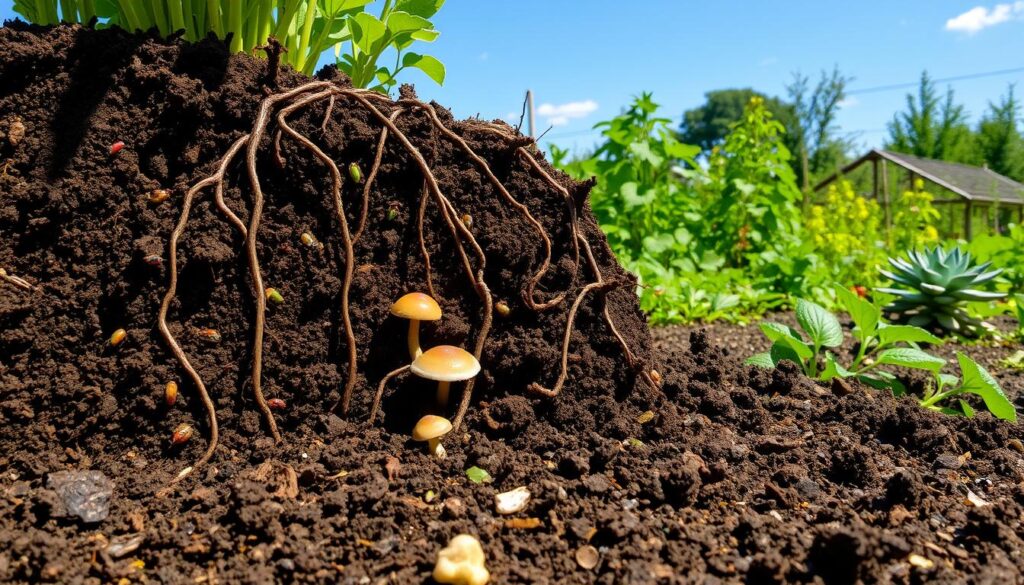
- Improved crop yields and plant growth
- Increased soil carbon sequestration
- Enhanced ecosystem biodiversity
- Reduced soil erosion and water pollution
By focusing on soil health in permaculture, farmers help create a more sustainable food system. This approach is good for the environment and supports organic farming’s long-term success.
| Soil Health Indicator | Permaculture Practice | Benefit |
|---|---|---|
| Soil Organic Matter | Composting and mulching | Improved soil structure and fertility |
| Soil Biota | Introducing mycorrhizal fungi | Enhanced nutrient uptake and plant growth |
| Soil Erosion | Conservation tillage and cover cropping | Reduced soil loss and water pollution |
Components of Soil Ecosystems
Soil ecosystems are complex and dynamic. They have many parts that work together to keep soil healthy. Microorganisms are key, breaking down organic matter and recycling nutrients. Bacteria and fungi are vital, helping to make nutrients available to plants.
Soil structure and composition are also crucial. The way soil particles are arranged and the presence of organic matter affect water-holding, aeration, and nutrient availability. Organic matter, like plant residues and decomposed microorganisms, improves soil structure and fertility. This supports plant and microorganism growth.
The interaction between these components is vital for soil ecosystems. For instance, microorganisms break down organic matter. This improves soil structure and composition. This complex relationship is key for plant growth and soil health.
| Component | Role in Soil Ecosystems |
|---|---|
| Microorganisms | Decompose organic matter, recycle nutrients |
| Soil Structure and Composition | Affect water-holding capacity, aeration, nutrient availability |
| Organic Matter | Improves soil structure and fertility, supports plant growth |
In summary, soil ecosystems are complex systems. They rely on the interaction of various components, including microorganisms, soil structure and composition, and organic matter. Understanding these components and their roles is essential for maintaining soil health and supporting plant growth.
Designing Permaculture Systems for Soil Health
Permaculture design is a way to make sustainable ecosystems. It focuses on improving soil health to boost land productivity. By using permaculture principles, people can create systems that work well with nature. They use zones and sectors to make things more efficient.
Good permaculture design needs careful planning. It considers the land’s climate, topography, and plants. Techniques like mulching, cover cropping, and using organic amendments help improve soil health.
Zones and Sectors in Permaculture Design
Zones and sectors are key in permaculture design. They help sort and manage land based on its needs and features. This method builds diverse and strong ecosystems. Each zone and sector helps improve soil health and system productivity.
Techniques for Improving Soil Health
There are several ways to better soil health in permaculture systems. These include:
- Mulching: using organic materials to keep moisture in and stop weeds
- Cover cropping: planting crops to protect and enrich the soil between main crops
- Integrating organic amendments: adding natural stuff like compost or manure to boost soil fertility and structure
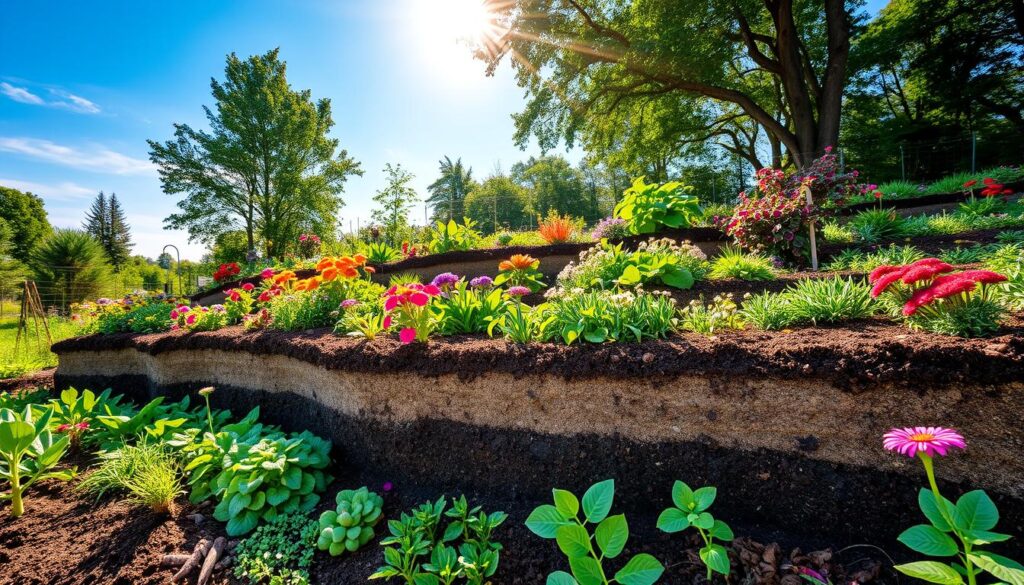
Using these methods in permaculture design helps create ecosystems that are healthy, diverse, and resilient.
| Technique | Benefits |
|---|---|
| Mulching | Retains moisture, suppresses weeds, regulates soil temperature |
| Cover cropping | Protects soil from erosion, adds organic matter, supports biodiversity |
| Integrating organic amendments | Improves soil fertility, structure, and overall health |
Enhancing Soil Fertility Through Permaculture
Soil fertility is key for sustainable farming. Permaculture has many ways to boost it. Crop rotation and diversity keep nutrients balanced. They also help beneficial microbes grow, making the soil healthier.
Composting is another important method. It turns organic waste into a soil booster. You can use everything from kitchen scraps to leaves, making the compost rich and diverse.
Crop Rotation and Diversity
Crop rotation changes what grows on the land. It makes the soil better and fights pests and diseases. Adding polycultures means growing many crops together. This is like nature and boosts biodiversity.
Composting Practices
Good composting mixes “green” and “brown” materials. “Green” stuff like food waste has nitrogen, while “brown” like leaves has carbon. Keep it moist and turn it often for the best compost. This compost makes the soil more fertile.
Using these permaculture methods, farmers and gardeners can make the soil better. They use less synthetic fertilizers and create diverse ecosystems. This is good for the soil, the environment, and our food.
| Practice | Benefits |
|---|---|
| Crop Rotation | Improves soil fertility, reduces pests and diseases |
| Composting | Creates nutrient-rich soil amendment, supports soil biota |
Utilizing Cover Crops in Permaculture
Permaculture uses cover crops to improve soil health. These plants are grown between crops to protect and enrich the soil. They help reduce erosion, promote nutrient cycling, and support beneficial organisms.
Cover crops can improve soil structure and hold more water. This is key in permaculture, aiming for a resilient ecosystem. By picking the right cover crops, farmers and gardeners can enhance soil fertility and cut down on external inputs.
Choosing cover crops depends on climate, soil type, and permaculture goals. Legumes, grasses, and brassicas are popular choices. They attract beneficial insects, suppress weeds, and add organic matter.
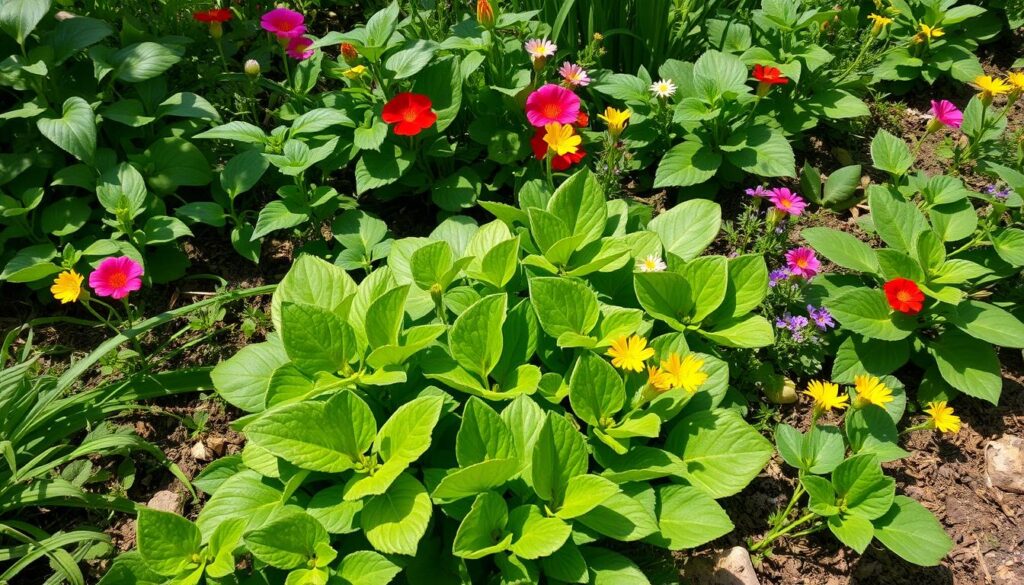
| Cover Crop | Benefits |
|---|---|
| Legumes | Nitrogen fixation, soil improvement |
| Grasses | Soil erosion control, weed suppression |
| Brassicas | Pest control, soil health improvement |
By adding cover crops to permaculture systems, farmers and gardeners make their ecosystems more diverse and resilient. This helps the system face challenges better and improve soil health.
The Role of Mulching in Soil Ecosystems
Mulching is key to keeping soil healthy. It involves using organic materials like leaves or wood chips to cover the soil. This helps keep moisture in, stops weeds, and controls soil temperature. It’s vital for plants to grow well.
The type of mulch used matters a lot. Organic mulch, like compost, adds nutrients as it breaks down. This helps beneficial microorganisms grow. On the other hand, inorganic mulch can block water and air, harming the ecosystem.
Types of Mulch
- Organic mulch: compost, well-rotted manure, leaves, straw
- Inorganic mulch: plastic, landscape fabric, gravel
Benefits of Mulching
Mulching has many benefits for soil. It improves soil structure, keeps water in, and boosts nutrient cycling. It also reduces erosion and weeds, helping soil health and biodiversity. Mulching is a natural way to manage soil, making it essential for a sustainable garden or landscape.
Integrating Livestock into Soil Management
Livestock integration is key in permaculture. It boosts soil health and fertility. Holistic grazing is a great method. It involves moving animals to different spots to mimic nature.
This method cuts down soil erosion and boosts organic matter. It also encourages biodiversity.
Manure management is also vital. Collecting and composting manure makes a nutrient-rich fertilizer. This reduces the need for harmful synthetic fertilizers.
Benefits include better soil fertility and structure. Crops grow better and are of higher quality. Soil erosion and water pollution decrease. Biodiversity and ecosystem services improve.
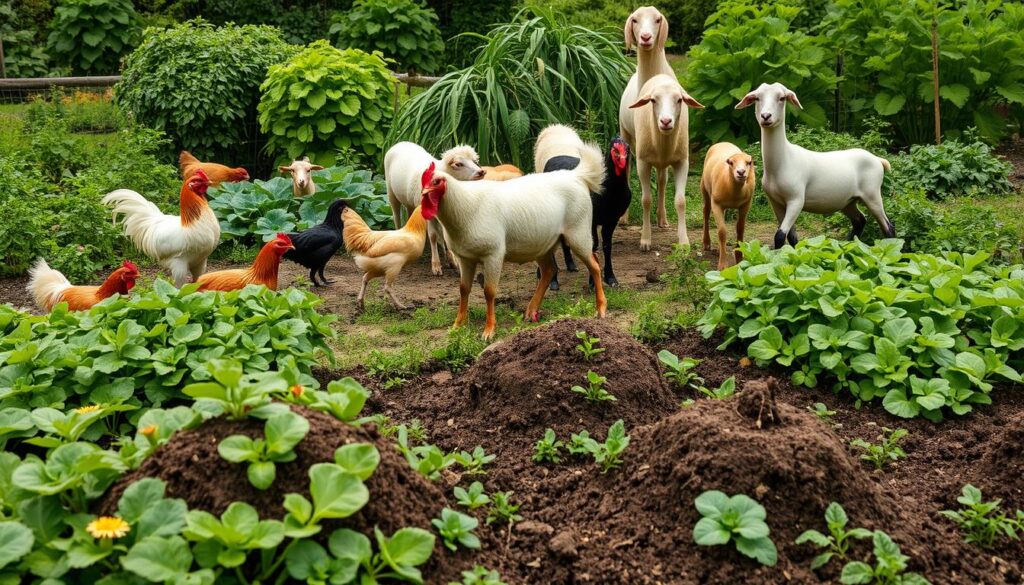
Using holistic grazing and manure management makes farming more sustainable. These methods promote soil health and reduce environmental harm. They also boost crop productivity, helping create a greener food system.
| Benefits | Holistic Grazing | Manure Management |
|---|---|---|
| Soil Fertility | Improved | Enhanced |
| Crop Yields | Increased | Improved |
| Environmental Impacts | Reduced | Minimized |
Water Management in Permaculture Soil
Effective water management is key in permaculture systems. It affects soil health and productivity. Permaculture focuses on saving water and using it wisely. Techniques like rainwater harvesting and drip irrigation help farmers use less water while keeping the soil fertile.
Water management in permaculture is all about looking at the big picture. It’s about conserving water with smart irrigation, harvesting rainwater for other uses, and managing water cycles to stop erosion and nutrient loss.
Techniques for Efficient Water Use
- Rainwater harvesting: collecting and storing rainwater for non-potable uses, such as irrigation and toilet flushing
- Drip irrigation: delivering water directly to the roots of plants, reducing evaporation and runoff
- Mulching: retaining soil moisture and suppressing weeds through the use of organic mulch
Importance of Water Conservation
Water conservation is vital in permaculture. It keeps the soil healthy, cuts down on waste, and boosts biodiversity. By saving water, farmers also lessen their environmental footprint and help make food production more sustainable.
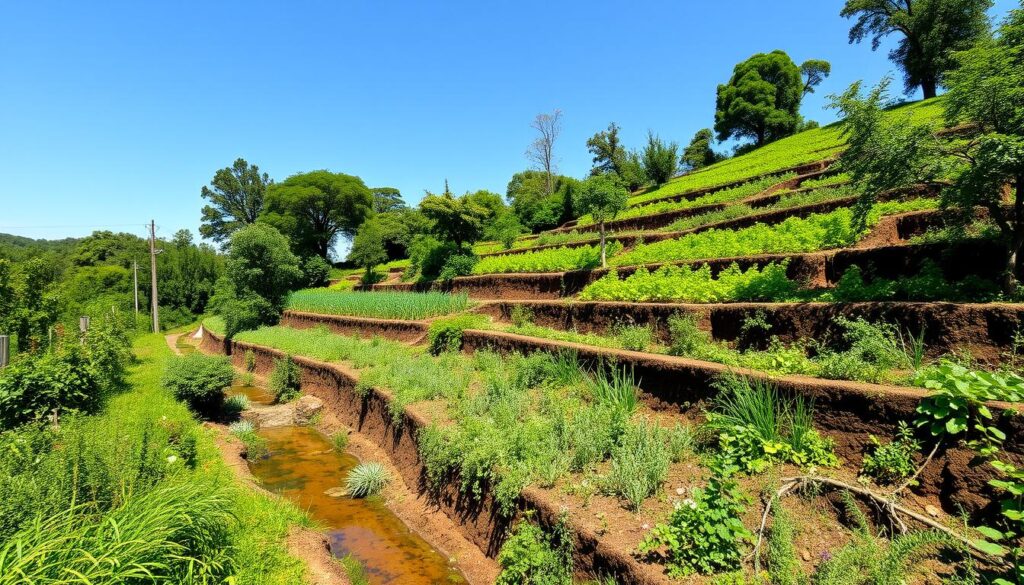
| Water Management Technique | Benefits |
|---|---|
| Rainwater Harvesting | Reduces water consumption, decreases stormwater runoff |
| Drip Irrigation | Increases water efficiency, reduces evaporation and runoff |
| Mulching | Retains soil moisture, suppresses weeds, regulates soil temperature |
Building Soil Carbon Sequestration
Soil carbon sequestration is key to fighting climate change. Permaculture helps by boosting soil carbon. This is done through carbon farming, making soil healthier and lowering carbon dioxide in the air.
Soil carbon is crucial. If we increase soil organic matter by 1 percent on 14 billion acres of land, we can lock away 256 billion tons of carbon. This shows how soil carbon sequestration can help fight climate change.
Understanding Soil Carbon
Soil carbon is vital for soil health. Knowing its role is key for good permaculture practices. We can increase soil carbon through cover crops, no-till farming, and organic amendments.
Methods to Increase Soil Carbon
Here are some ways to boost soil carbon:
- Using cover crops to enhance soil organic matter
- Implementing no-till or reduced-till farming practices to reduce soil disturbance
- Incorporating organic amendments, such as compost or manure, to increase soil fertility
By using these methods, we can improve soil health and increase carbon sequestration. This helps us move towards a more sustainable future through carbon farming and permaculture.
| Method | Benefits |
|---|---|
| Using cover crops | Enhances soil organic matter, reduces erosion |
| No-till or reduced-till farming | Reduces soil disturbance, increases soil carbon sequestration |
| Incorporating organic amendments | Increases soil fertility, enhances soil health |
The Role of Mycorrhizal Fungi in Soil Health
Mycorrhizal fungi are key to keeping soil health in check. They team up with plants in a special bond. This bond helps plants grab the nutrients they need, making them grow strong and healthy.
With over 100,000 known fungal species, the chance for mycorrhizal fungi to boost soil health is huge.
Some of the perks of mycorrhizal fungi include:
- Improved nutrient cycling and uptake
- Enhanced soil structure and water retention
- Increased plant growth rates, with an average increase of 20-50% in various agricultural settings
For more on mycorrhizal fungi and soil health, check out Mycelium Running. It dives deep into their role. Knowing about mycorrhizal fungi and fungal associations helps us improve soil health and support green farming.
Using mycorrhizal fungi in permaculture can really help soil health and keep ecosystems stable. By growing mycorrhizal fungi and boosting fungal associations, we can make our ecosystems stronger and more sustainable.
| Benefits of Mycorrhizal Fungi | Description |
|---|---|
| Improved Nutrient Uptake | Enhanced absorption of essential nutrients from the soil |
| Increased Plant Growth | Average increase of 20-50% in various agricultural settings |
| Enhanced Soil Structure | Improved water retention and soil stability |
Permaculture Techniques for Controlling Erosion
Permaculture is key in fighting erosion, keeping soil healthy, and stopping environmental harm. It uses plants to hold the soil in place, stopping landslides and erosion. Techniques like terracing and contour planting slow down water flow, letting it soak into the ground.
Erosion Control Methods
Effective methods in permaculture include:
- Terracing: This makes flat or sloping beds on hillsides to stop soil erosion.
- Contour planting: Planting crops across slopes to slow down runoff and erosion.
- Cover cropping: Planting crops between cycles to protect the soil from erosion.
Importance of Vegetation
Vegetation is vital for stopping erosion. It keeps the soil stable and reduces runoff. Agroforestry and silvopasture help plants grow, lowering erosion risk and improving soil health. Using these methods, we can control erosion and keep our soils healthy.
These permaculture techniques help fight soil erosion, boost soil health, and support green farming. They also help biodiversity, improve water quality, and fight climate change.
| Permaculture Technique | Erosion Control Benefit |
|---|---|
| Terracing | Reduces soil erosion by slowing down runoff |
| Contour planting | Reduces runoff and soil erosion by allowing water to infiltrate the soil |
| Cover cropping | Protects the soil from erosion by providing ground cover |
Practical Tools for Soil Monitoring
Soil monitoring is key in permaculture. It helps farmers and gardeners check their soil’s health and fertility. Soil testing kits are great for this. They measure nutrients, pH, and more, helping to spot areas for improvement.
Moisture monitoring is also vital. Tools like probes or tensiometers show how much water is in the soil. This info helps decide when to water, avoiding harm to plants and soil.
Soil monitoring offers many benefits. It improves soil’s fertility and structure. It also boosts crop yields and plant health. Plus, it helps with ecosystem services like carbon sequestration and biodiversity.
By using these tools, people can manage their soil better. This promotes sustainable agriculture and healthy ecosystems.
Community Involvement in Permaculture Projects
Community involvement is key in permaculture projects. It brings people together and makes them feel responsible for the work. By working with the local community, permaculture projects can improve soil health and strengthen communities.
One way to get people involved is through education and outreach. Organizing workshops and training sessions can teach people about permaculture’s benefits. For example, over 500 UME Master Gardeners learned through webinars and in-person events, showing how big the impact can be.
Some effective strategies for community involvement include:
- Developing partnerships with local organizations and businesses
- Creating educational programs and resources
- Hosting community events and workshops
These methods help build a sense of community. They encourage people to join in permaculture projects.
Together, communities can make permaculture systems thrive. These systems improve soil health, biodiversity, and sustainable living. As more people join permaculture projects, we’ll see better environmental outcomes and stronger communities.
| Strategy | Benefits |
|---|---|
| Partnerships with local organizations | Increased resources and expertise |
| Educational programs and resources | Improved knowledge and skills |
| Community events and workshops | Enhanced community engagement and collaboration |
Case Studies: Success Stories in Soil Ecosystems
Permaculture has been a game-changer in many parts of the world. It has improved soil health and made ecosystems more resilient. These case studies show how permaculture works in different places. For instance, a project in Australia turned a damaged area into a thriving landscape. It greatly improved soil fertility and biodiversity.
Other permaculture success stories include cleaning polluted soil with mycoremediation. Also, regenerative agriculture has boosted soil’s ability to hold carbon. These stories show permaculture’s power to tackle environmental issues and support sustainable growth. By looking at these case studies, we learn a lot about permaculture’s impact on soil ecosystems.
Important lessons from these projects are clear. Holistic design, community involvement, and monitoring are key. These lessons help us increase permaculture’s reach and encourage more people to use sustainable land practices.
Future Trends in Permaculture and Soil Health
As we face environmental challenges, future trends in permaculture and soil health are crucial. Practices like regenerative agriculture and agroforestry are gaining popularity worldwide. They focus on soil health, biodiversity, and ecosystem services, helping to remove carbon from the air.
Soil technology is a key area in permaculture. It involves using cover crops, crop rotation, and organic amendments to enrich soil. This approach reduces the need for synthetic fertilizers and pesticides, making soils more resilient and productive. It also helps combat climate change by storing carbon in soils.
New permaculture innovations are being explored, like using mycorrhizal fungi to boost soil health. Integrating livestock into farming systems also enhances nutrient cycling. These methods could revolutionize how we grow food, making it more sustainable and regenerative.
The future trends in permaculture and soil health are full of promise. By embracing permaculture innovations and focusing on soil technology, we can build more sustainable food systems. This will help fight climate change.
| Permaculture Practice | Benefits |
|---|---|
| Regenerative Agriculture | Improved soil health, increased biodiversity, enhanced ecosystem services |
| Agroforestry | Increased crop yields, improved soil fertility, enhanced carbon sequestration |
| Mycorrhizal Fungi | Improved soil health, increased nutrient uptake, enhanced plant growth |
Conclusion: Embracing Permaculture for Resilient Soils
Permaculture is a powerful way to make our landscapes strong and sustainable. It works with nature, grows many different plants, and uses resources wisely. This approach helps create soil that’s full of life and supports healthy plants and tiny creatures.
Summary of Key Points
We’ve looked at how important soil is in permaculture. We’ve talked about the different parts of soil ecosystems and how to make soil better. We’ve also seen how using animals, planting cover crops, and working with fungi can make soil stronger.
Call to Action for Individuals and Communities
Our planet needs us to care for the soil. By using permaculture in our gardens, farms, and towns, we can help make the soil better. We urge everyone to learn about permaculture, start improving the soil, and encourage others to do the same. Together, we can make a better future for our planet.
